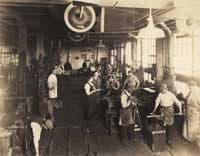
Courtesy of Samuel Yellin Metalworkers
"...the traveler finds again a past of his that he did not know he had: the foreignness of what you no longer are or no longer possess lies in wait for you in foreign, unpossessed places."
Italo Calvino
Introduction
Not until being immersed in Yale National Institute Seminar Leader Joseph Roach's stimulating two-week colloquium entitled "Invisible Cities"—coupled with mandatory readings, among them Italo Calvino's novella that possessed the same title—did I begin to actively consider what constitutes residing in an invisible city. Based on our course of study, I have drawn the conclusion that to reside connotes being a foreigner within one's surroundings: that being a foreigner in one's environment impacts countless numbers of Americans—including many students and their families who reside within or around major municipalities. This belief, in part, serves as the foundation for my curriculum unit, Whence We Stand.
I am an elementary school instructor at the Davis Street Arts & Academics Interdistrict Magnet School in New Haven, Connecticut. Since 2009, my classroom composition has been quite diverse, comprised of an average of 25 students per year with 4% interracial, 8% Asian-American, 12% Euro-American, 16% Hispanic/Latino-American, and 60% African-American students represented. The latter classification includes American-born blacks and second or third generation blacks of African and/or Caribbean ancestry. The majority hail from single-parents, low-to-moderate and middle income households. Most enter Grade 3 reading below grade level, faring proficient or below average across primary academic disciplines.
Upon canvassing my third graders, I learn that outside of occasional school excursions, the majority have never experienced key landmarks in New Haven. Parent-student-teacher discussions reveal that many who reside within the low-income pockets of New Haven proper barely travel beyond the confines of their immediate neighborhoods. Student-parent-teacher discussions additionally divulge that outside of school interaction, students bussed in from outlying communities—from as far as Guilford and East Haven to Milford —minimally set foot in the New Haven. Limited transportation, lack of time due to hectic, overlapping work schedules, limited economic resources, and/or misconceived notions about the city as a whole are oftentimes the rationale for non-visitation. The results: many of our young learners are impacted by "invisibly visible" cultural and socio-economic boundaries that impede their ability to fully appreciate and/or embrace being part of a broader, historically and culturally rich municipality. I have found that many students (and parents) too seem to adopt a narrow, "comme ci, comme ça" view of the city and its landmarks, observing them as nothing more than venues to be quickly traversed. "Foreigners in a familiar yet distant land ," they do not generally know or embrace that landmark areas right in their midst—such as the Nine Square District and its central square, the New Haven Green—and surrounding communities are landscapes layered in visible and invisible history, a history with which they may be intrinsically connected. The title of this curriculum unit—"Whence We Stand" –helps to symbolize that experiential bridge between past and present.
Based on this premise, Geography, Social Studies, Math and Language Arts could be taught so engagingly that they take on new meaning, enhanced through a new approach in exploration possibilities. Curriculum could be tweaked to help students make text-to-self-to-New Haven citizen connections. Making invisible cities visible could engage young learners who too often are disengaged because of invisible boundaries. How do we bring such a unit study to life? Could we implement visually interactive, hands-on teaching approaches to help students experience geographic transformation of their city over centuries? Could such an approach be used to help an often disenfranchised student population and their families—foreigners within familiar surroundings—see their embrace a city and proudly embrace the city and its history as their own? I contend, "Yes! Such exploration is doable"
Introducing such a pedagogic approach to young learners would spark immediate inquiry: Who were the first inhabitants of the region? Has the population changed over the ages, and if so, why and how? What was life like during the community's formative years? What were the characteristics of the region during the 17th through 20 th centuries? Are traces of those attributes visible today? These and other student-initiated questions are the focus of Whence We Stand: A Visual/Geography/History Adventure.
Targeted at students in Grade 3, but modifiable for students in Grades 2 through 5, Whence We Stand aligns with Connecticut Core Curriculum State Standards. The unit embraces a multidisciplinary approach, combining Geography, Social Studies, Language Arts (with emphasis on narrative writing), and Mathematics (with emphasis on Geometry), taking an up-close look at New Haven's geographic and historic development past and present. Through historical research, community walking tours, excursions to the New Haven Green, New Haven Historical Society, and the Center Church, and a complementary "photo-tour past and present," third graders will immerse themselves in background information regarding the transformation of the New Haven green and adjoining cross streets (to include Church, Elm, College, and Chapel) since the 18th century. Coupled with related readings, a photo expedition, memory-mapping exercise, and complementary writing activities, students will (1) come to understand the concept of time and place, and its impact on physical and human characteristics and interactions; (2) grasp the concept of regions and their impact on lifestyles; (3) immerse themselves in the shoes of individuals who resided and/or frequented the area past and present; and (4) compare and contrast photographic and historical images to get a sense of changing landscapes and their overall impact on community over time.
Students will be assessed based on the completion of project-based writing assignments used to convey their overall understanding of subject matter. As a culminating, whole-group activity, students will create an oversized poster representation of the New Haven Green and surrounding thoroughfares past and present. Literary and artistic creations will be showcased within select venues within their classroom, school, or community-based venue (e.g., the New Haven Public Library, City Hall lobby…).

Comments: